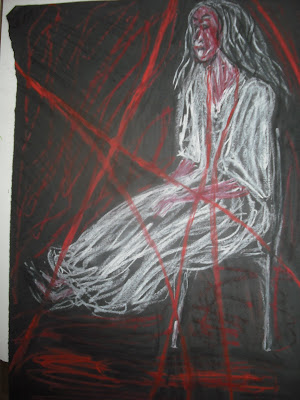
Islington artist Michael Jannetta has had a long and varied career, spending many years travelling around Europe, painting landscapes, portrait commissions and public murals. As an abstract painter, he takes inspiration working directly from nature. He is currently a member of Studio Upstairs, an open art studio in Dalston, where he also regularly teaches painting classes. In this interview he shares some insight into his practice.
Can you tell us about some of your experiences working outside in public?
When I was painting in Bosnia, a week before the war, there was tension and unrest amongst the villagers, as you can imagine. I wasn’t sure if I was welcome at all, but what was surprising was they hadn’t even seen a painter. The whole village would watch me paint, which was nerve racking. Paints were hard to get hold of. Art was such a novelty and the children were fascinated, transfixed. In Italy, wherever you painted someone would approach and invite you into their homes to see their own work. People were either artists or appreciative. Italy is a very cultured country.
.
What benefits do you get by painting outside?
This is what I love most, direct contact with people. Sharing experiences about art and attracting other artists. Any town or village I passed, I inevitably meet other artists- who were much more sociable. Interaction was beneficial to the process. It is very similar to when I was a busker, feeding off reactions. In England, you could paint in the middle of the street and no one would come up to you. It’s a joy to change my landscape every day, which you don’t get from the studio- stuck with artificial light and the same view. It’s not really possible to be bored when you work outside.
You have travelled extensively and experienced many different cultures. Was this a conscious decision as an artist? How does it feed into your work?
It wasn’t conscious. It was at a very young age I decided to gain knowledge of the world around me. To answer the inevitable question, “What is it all about?”. In those travels, I came across artists, which obviously attracted me. As a result, in time, after losing most jobs, it seemed the only thing left to do- or could do.
But the experiences definitely feed into my work. It taught me the things I never learned at school. My knowledge has come from the pursuit of art, rather than formal education. Subjects, concepts, that are of no personal interest to me become fascinating when I approach them as an artist.
What advice would you give to anyone who has fear or trepidation about working in public?
Find the best spot for a day of relaxation and pleasure. Whatever you produce, even just a couple of marks, stick it up on your wall at home. Don’t analyse or question the outcome of your attempt. That must come much later. It is essential just to practice and experience art.




















